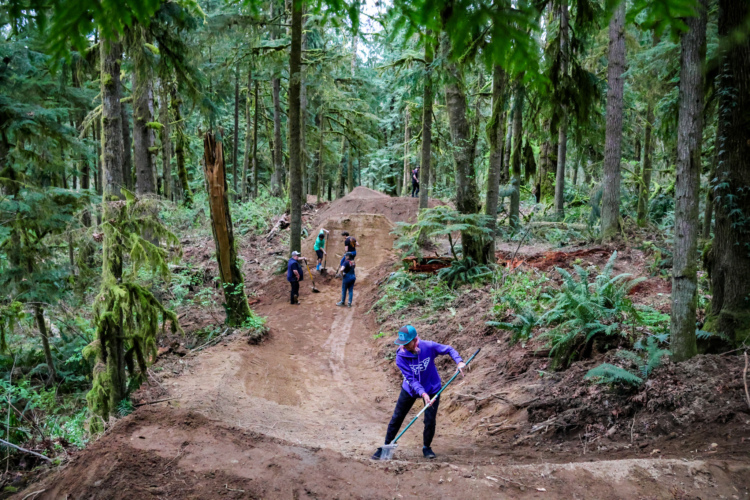
On a trip to visit family about a year ago, I set out on an early morning ride at one of the local trail systems nearby. Since it was my first time riding in this area, I researched trails the night before and had a route in mind.
The first trail began with a particularly steep bit, which I knew thanks to Trailforks. What went unmentioned was the 18-inch rut in the middle of the trail. Luckily, the rut didn’t take up all the real estate on the trail, and I attempted to stay out of it.
I made it ten feet before my wheels slid into the rut. What followed was 100 feet or so of me hanging on, riding the brakes, and trying to survive the rut’s path.
Let’s be clear about ruts
It may be important to distinguish what we refer to when we say “ruts.” There seem to be a few types of rutted trails we typically encounter. First are the ruts on flatter trails, the product of riding when conditions are too wet. Likely, the “freeze/thaw cycle” has also helped form these ruts.
While these frozen, “tire-track” ruts can be challenging to ride, they usually are of lower consequence and, ultimately, are not the “ruts” we are concerned about riding.
Ruts can be common in flat corners, as rider after rider uses the same space to complete a turn. These ruts become make-shift berms, allowing riders to carry more speed through the corners they occupy.
For this article, we will talk about ruts that tend to have higher levels of consequence. These ruts are usually on particularly steep sections of trail, where gravity, weather, erosion, and our tires have taken their toll.
Of course, one rut will be different from the next. “Quantifying rutted trails is hard,” Russ Risdon pointed out as he helped teach me, intellectually at least, about riding rutted trails.
Teaching and instructing aren’t new for Risdon. He has taught pilates for the last 23 years, guided mountain bike trips with Cog Wild for 13 years, and been a PMBIA-certified coach over the previous eight years.
Instead of avoiding ruts, as I tried to do, Risdon embraces them, using ruts to his advantage. “I’m a big downhiller, so…I’ll look for ruts to, for example, help me control my speed,” Risdon said. “You’re going to be on highspeed, steep trails, and you have to use those ruts, or you’re going to be chucked.”
Risdon doesn’t downplay the technicality of rutted trails. “You can think of ruts as a blessing and a curse,” Risdon told me. I hoped to move away from the curses of ruts and see the blessings.

Each rut is unique, but there are right and wrong ways to ride them
Like most mountain bike features we hope to improve on, it is easier for a coach when the specific feature is in front of them. Had Risdon and I been standing at a particular rut, he would give precise instructions—stand tall here, compress there, brake here, etc.
Without the convenience of a specific rut, specific coaching is all but impossible. But, Risdon pointed out two general mistakes he sees riders make when attempting rutted trails—poor braking and body position.
He also sees an overall lack of confidence, which, Risdon feels, “sets you up for failure from the beginning.” Ruts can perpetuate this negative feeling as they are a technical trail feature where it is easy to get out of control.
Braking
With erosion being a primary culprit in rut formation, rutted trails lean toward the looser side. As you can imagine, this means less braking traction.
Risdon often sees riders on their brakes the entire way through a rut. Instead, he recommends using the rut itself as a means of controlling speed.
“As I’m dropping into that steep terrain, I’m looking for that variance in the terrain where I can use my tires to push off to help control my braking or cornering,” Risdon said. “It can be challenging when you get into a rut and are braking.”
Due to the typically narrow nature of the rut, the loss of control from braking can cause your bike to bounce around off the sides of the rut. This leads to further loss of control and, eventually, a crash.
“Braking is ineffective if you’re skidding,” Risdon said. “I’m going to be scaring myself if the rear wheel shifts side to side.”
Risdon recommends using the front brake more than the rear to avoid skidding. “I get nice and low and drag my brakes…but I am smart about how I modulate my front brake versus the rear.”
However, Risdon doesn’t recommend riding your brakes the entire time. Finding the proper braking points in a rut will depend on the characteristics of each specific rut. If you are unfamiliar with a trail, Risdon recommends walking the rut first. “Study the rut…and plan ahead.”
Rather than riding those brakes throughout the rut, Risdon recommends looking for features within the rut that will help control speed. Turns become catch-berms, and flatter bits become braking points.
Body positioning
When dropping into a steep, rutted trail, we naturally tend to move our bodies back on our bikes. We like to get as far away from the danger as possible; in this case, the threat is going over the bars. Risdon said this is a common mistake he witnesses.
“You don’t want to be over the back [of the bike]. If you get over the back, that will mean minimal front traction and control.” It may feel counterintuitive, but Risdon stressed control coming from our weight on the handlebars.
Instead of being far back on the bike, try to have a neutral body position. “You want to be as centered as possible,” Risdon said. “That gives you options…you can move the bike underneath of you; you can move front to back, side to side, so you have all of those options.”
Risdon said this centered body position allows for adjustments to the bike and allows you to use your body weight for control. “If I have my weight back, I’m taking all the control from the front. I can’t turn my back wheel.”

Mental game
Besides proper braking and body position, Risdon feels that what happens between our ears is a significant factor. Time and time again, he sees riders get into their heads too much, and lack confidence.
“If you tell yourself that you can’t do something, you set yourself up for failure,” Risdon believes. “We tense up and are visualizing the worst. Our mental situation will mess up our physical outcome.”
But Risdon doesn’t recommend reckless riding, but rather knowing and respecting your skillset. If you are unsure if you have the needed skill set, you may not be ready.
Help with a rut without actually riding the rut
If you want to prepare for a rutted trail without actually dropping in, Risdon recommends moving away from the flow trails and looking to more technical descents. “Technical trails help you remain loose and learn how to pick a line through rough terrain.”
Risdon also pointed out that flow trails tend to be wider, which doesn’t help prepare you for the typically narrow bottom of a rut. A trail feature that Risdon said can help are skinnies.
“Sometimes you have to treat [a rutted trail] like a skinny. You have to focus; if you are looking outside of the rut, you can catch the side and crash.”
Our bike setup for technical trails will likely translate to rutted trails better. Not wanting to wallow in air pressure, we might have tire and suspension a bit stiffer for riding flow trails. This doesn’t translate well to rutted trails. Less air in the tires and a softer suspension, more common for tech trails, helps with traction in the ruts.
Taking Risdon’s recommendations to the trail
Having Risdon trailside, pointing out where I should brake or what I was doing wrong, would have been nice. Instead, I did the next best thing and took his advice to the trails.
A winter trail I frequent has a fairly steep section near the end, with a sandy, loose rut formed in the middle of the trail. While it isn’t as deep as other ruts, it takes up the entirety of the trail, leaving one option for descending—you have to ride the rut.
I thought body position and braking were my big takeaways from my conversation with Risdon. Little did I know that the mental aspect would play the most significant role for me.
Immediately, I found myself over the back of the bike, riding the rear brake. As Risdon said, I wanted to “get away from the danger.” I didn’t realize how difficult it would be to remain centered over my bike.
After stopping and gathering myself, I continued down the rutted steep section of trail, fighting the fear and attempting to stay more neutral. The amount of control I felt was noticeably more significant.
It wasn’t until I trusted in my skill and put my weight toward the front that I could feel what Risdon was talking about. Now, I could see how to push into corners and use the turns of the rut to help control my speed.
In no way was I immediately successful at this. I’m sure that first descent was still trash, but something clicked. For me, it was getting over the fear and mental block. Once I did that, the rest started falling like dominoes.






